
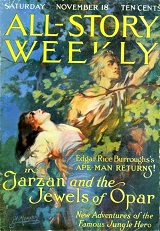 Tarzan (1951-1953) aired “The Manuema” on January 25, 1951. For newcomers, we repeat the introduction to a Tarzan episode from February of 2017: From 1932-36 Tarzan on radio consisted of three long-running serials: Tarzan of the Apes, Tarzan and the Diamond of Asher, and The Fires of Toth. Tarzan was played by silent film actor James H. Pierce and Jane was played by Burroughs’s daughter Joan. Pierce had attended a party held by Burroughs where he met Joan. ERB asked Pierce if would appear as Tarzan in ERB’s next silent Tarzan picture. Pierce replied that he was to appear in another film titled Wings. ERB nevertheless convinced Pierce to become Tarzan and he gave up his role in Wings. Pierce’s role in Wings was then filled by a relative newcomer named Gary Cooper, and Wings would walk away with the first Oscar for what is now known as Best Picture in 1929. Such blow the fickle winds of Fate. On the up side, James Pierce would wed Joan Burroughs in 1928 and they would remain together until their deaths (Joan in 1972 and James in 1983).
Tarzan (1951-1953) aired “The Manuema” on January 25, 1951. For newcomers, we repeat the introduction to a Tarzan episode from February of 2017: From 1932-36 Tarzan on radio consisted of three long-running serials: Tarzan of the Apes, Tarzan and the Diamond of Asher, and The Fires of Toth. Tarzan was played by silent film actor James H. Pierce and Jane was played by Burroughs’s daughter Joan. Pierce had attended a party held by Burroughs where he met Joan. ERB asked Pierce if would appear as Tarzan in ERB’s next silent Tarzan picture. Pierce replied that he was to appear in another film titled Wings. ERB nevertheless convinced Pierce to become Tarzan and he gave up his role in Wings. Pierce’s role in Wings was then filled by a relative newcomer named Gary Cooper, and Wings would walk away with the first Oscar for what is now known as Best Picture in 1929. Such blow the fickle winds of Fate. On the up side, James Pierce would wed Joan Burroughs in 1928 and they would remain together until their deaths (Joan in 1972 and James in 1983).
(Above left: All-Story Weekly, December 18, 1916 – Above Right: Edgar Rice Burroughs, 1875-1950)
(Photo below left: Joan and James Pierce photo cropped to show the left half of their wedding invitation, dated August 8, 1928. From the Danton Burroughts Archive Collection.)
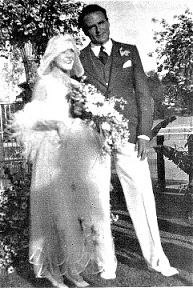 It is impractical to run lengthy serials here, though we have run a few consecutive episodes with specific self-contained adventures. Each of the 1930s Tarzan serials ran to approximately 40 episodes, give or take, and timed out from 8-12 minutes each. There would be a new Tarzan episode in the much longer story arc every two or three days throughout the week. After the trio of initial serials in the 1930s, the Golden Age of radio would produce no further Tarzan adventures until 1951, at which time his new exploits would run until 1953, when many radio shows were gradually being phased out in favor of television. Lamont Johnson now played the Lord of the Jungle, and in contrast to the earlier 1930s serials (and the famous Johnny Weismuller Tarzan pictures), Tarzan would speak intelligent English rather than the “Me Tarzan, you Jane” dialogue many have come to think of when the subject comes up.
It is impractical to run lengthy serials here, though we have run a few consecutive episodes with specific self-contained adventures. Each of the 1930s Tarzan serials ran to approximately 40 episodes, give or take, and timed out from 8-12 minutes each. There would be a new Tarzan episode in the much longer story arc every two or three days throughout the week. After the trio of initial serials in the 1930s, the Golden Age of radio would produce no further Tarzan adventures until 1951, at which time his new exploits would run until 1953, when many radio shows were gradually being phased out in favor of television. Lamont Johnson now played the Lord of the Jungle, and in contrast to the earlier 1930s serials (and the famous Johnny Weismuller Tarzan pictures), Tarzan would speak intelligent English rather than the “Me Tarzan, you Jane” dialogue many have come to think of when the subject comes up.
We have run 7 consecutively numbered episodes from the 1932-36 era, and this is the 10th from the modern 1951-53 era.
“The Manuema” has Tarzan, due to a prolonged drought, helping a starving, thirsty, rapidly weakening tribe of lowland villagers. Leading them into higher ground and the mountains where there is more food and water, they encounter a tribe of savage cannibals (the Manuema) also in dire need of food and water. The Manuema believe that only by sacrificing and then eating a young boy and a grown man will the gods once again send them sustenance. Sure enough, they surprise the tribe Tarzan is helping and capture a young boy, and it is up to Tarzan to free him before the Manuema turn him into hors d’oeuvres. Tarzan, with the help of a young girl from the tribe he’s helping, devises a clever scheme to fool the Manuema–but not before other dangers must be averted, such as a man-eating crocodile and the impending threat of an active volcano. Sounds like fun, right? Note also that at the very end of this episode the announcer teases the next week’s episode which is “The Siren of Omdurmara.” We ran this episode on July 15, 2017 and for those wishing to hear it, click here.
Play Time: 25:57
{Seeking more adventure after listening to this Tarzan episode, our neighborhood explorers found more than enough to keep their over-active imaginations racing as they headed for the corner drugstore/newsstand. Startling Stories (1939-55) was sprinkling its covers and stories with more modern fare in amongst its more traditional offerings of planetary romance and science fantasies. It was bi-monthly in 1951. Thrilling Wonder Stories (1936-55) seemed also to be peppering some of its covers and stories with a slightly more modern sensibility, though it still hewed to grand space adventures on other worlds. In 1951 it was a bi-monthly. Long a favorite, Weird Tales (1923-54) never failed to solicit creepy thrills and chills, the kind guaranteed to keep youngsters (and oldsters) coming back for more. In 1951 it was also a bi-monthly.}
[Left: Startling Stories, Jan. 1951 – Center: Thrilling Wonder, Feb. 1951 – Right: Weird Tales, Jan. 1951]
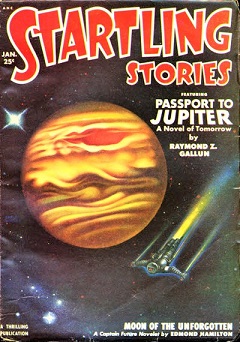
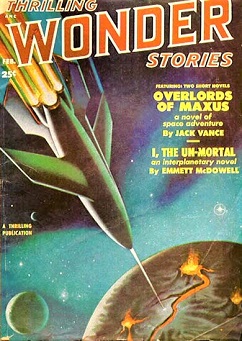
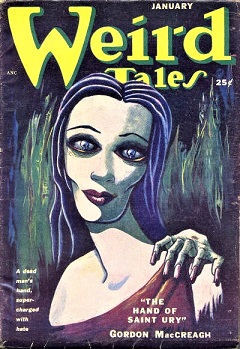
To view the entire list of weekly Old Time Radio episodes at Tangent Online, click here.